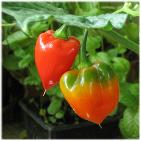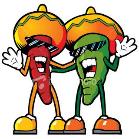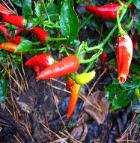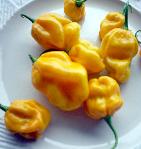
THE PEPPER ZONE NEWSROOM


| Here's what's Happening in The Pepper Zone Newsroom... |
Copyright 2009 The Pepper Zone. All rights reserved
The chili pepper was first cultivated in Central and South America around 3000 BC Christopher Columbus brought seeds from the New World back to Europe in 1493. Chile peppers are consumed around the world and now dominate the world spice market with India being the largest producer. What Makes a Pepper Hot? Many believe it’s the seeds that give peppers their Hot Pepper Plant “hotness”, but actually it is a substance called capsaicin that is concentrated in the veins of the fruit (not the seeds). Capsaicin stimulates the nerve endings in your mouth and tricks your brain into feeling the pain. The brain then reacts and releases endorphins. The result is a mild euphoria that some believe can cause peppers to be mildly addictive due to this sensation the body feels. Hot Pepper Health Benefits In addition to their heat, Chile Peppers bring health benefits. They are a good source of potassium, iron, vitamins A, B, C and E, low in sodium and calories, and have no carbohydrates. Peppers improve digestion and can increase your metabolic rate by up to 25%, which is beneficial to the dieter. Visit Health Benefits of Hot Peppers to learn more. Hot to Put Out the Heat What is the best way to put out that fire after eating a pepper that’s a little too hot? Scientists report that capsaicin breaks down in fats. So, some milk, sour cream or a little ice cream might help. Foods with increased fat have more capability of squelching the fire. Some believe that starch helps put out the flame. The popular cure in Mexico is to consume beer. |









| Chili Fact: |
| What is the world's hottest pepper? According to Wikipedia and the Guninness Book of World Records, the Naga Jolokia variety of chili pepper grown in the hilly terrain of Assam, India is reportedly much hotter than the infamous habanero. Other names for this variety are Bih Jolokia and Bhut Jolokia. It has a reported heat index of just over 1,000,000 Scoville Heat Units, compared with 577 for the red savina habanero. Most published values for habaneros top out at about 300,000. The Naga Jolokia is about three times as hot as the average habanero |


Little Rascals - Spanky Eats Tabasco Sauce




